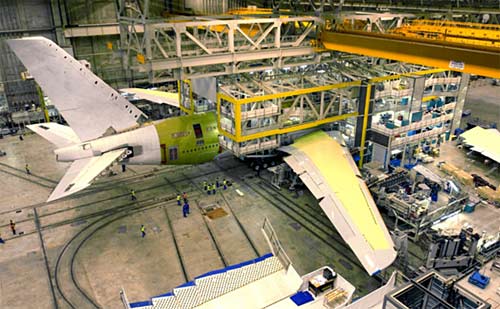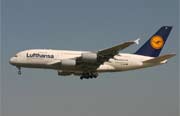|
|
| Airbus A380-page Home |
Widebody Aircraft Parade
 The first customer of the Airbus A380 was Singapore Airlines
Airbus A380The Airbus A380 is the world's biggest and heaviest passenger airliner. It is Airbus's answer to the Boeing 747 Jumbo Jet and although not much bigger in overall dimensions, it is a lot heavier and it has two passenger decks over the full length of the fuselage.
A3XXIn June 1994 Airbus adopted the designation 'A3XX' for its proposed big airliner. One of the designs under study was a combination of two A340-fuselages 'glued' together side-by-side, but later the A3XX design became a double-decker with two passenger decks. It still took many years until the decision to develop the aircraft was taken. Airbus officially launched the project on 19 December 2000. The aircraft didn't become 'A350', but 'A380', inspired by the double deck, a concept that looks like an '8'.  Two A380s taxiing at Frankfurt
On 27 April 2005 the Airbus A380 flew for the first time from Toulouse Blagnac, where the final assembly of the air giant takes place. Five A380s were involved in the flight test programme and the aircraft type was certified by EASA and FAA on December 12, 2006. Service entry with Singapore Airlines, originally planned for March 2006, had to be postponed until October 2007, because of a very slow start of the production. One of causes were expensively to recover mistakes with the complex wiring of the aircraft. The mistakes were the result of the use of different versions of the CATIA design software by Airbus facilities in different countries. First commercial flightAirbus delivered its first 'Megajet' or 'SuperJumbo' to Singapore Airlines on 15 October 2007. The first commercial flight took place on 25 October 2007 from Singapore to Sydney. In Spring 2012 Airbus had sold 253 A380s and delivered around 70. Among the first users are Singapore Airlines, Emirates, Air France, Qantas, Lufthansa, Korean Air and China Southern. The biggest customer so far is Emirates. This airline ordered 90 A380s.  One of the A380 users is China Southern Airlines - Photo: Airbus
The A380 is popular among the travelling public. The cabin offers a lot of floor space, which can be used for bars, beauty salons, shops, and restaurants. For example: Emirates offers a bar lounge and seating area on the upper deck, and, a remarkable novelty: a shower cabin for first class passemgers. Most airlines will prefer to install as many seats as possible, however. On the maindeck there is 10-abreast seating in economy class with two aisles, although 11-abreast is also possible. On the upperdeck seating in economy class is 8-abreast. The upper and lower decks are connected by two stairways, fore and aft. The basic version is the A380-800 with 525-seats in a three-class configuration. In charter-layout there is even space for up to 853 passengers. Cockpit Cockpit of the Airbus A380. - Photo: Airbus
The paperless cockpit has side-sticks for controlling the aircraft, like all Airbus-models have since the Airbus A320. Flight information is presented on eight liquid crystal displays.
Composite materials22 percent of the A380's airframe consists of composite materials like carbon-fibre reinforced plastic, glass-fibre reinforced plastic and quartz-fibre reinforced plastic.They are used in wings, fuselage sections, tail surfaces, and doors. The A380 is the first commercial airliner with a central wing box of carbon fibre reinforced plastic. The composite material GLARE (GLAss-REinforced fibre metal laminate) is used in the upper fuselage and on the leading edges of stabilisers. Glare is built-up of alternating layers of aluminium and glass fibre reinforced material. It saves weight and has more structural strength.  A380 final assembly in Toulouse. - Photo: Airbus
The A380 has an advanced fuel system, which helps actively controlling the aircraft in flight. Because before take-off fuel in the wing makes the wing bend too much, fuel is mainly kept in the inboard tanks and in tailplane tanks. Later, when the aircraft is in the air, the fuel is gradually pumped into the wing tanks. The system helps to control the centre of gravity and reduce drag. Drag is also reduced by wingtip fences like on the A310 and A320.
Future versionsAt the moment only one basic version of the A380 is available, the A380-800 with 525 up to 853 seats. Airbus had planned an A380-800F cargo variant, however, because of the production delays customers cancelled all 27 orders for freighters or converted them to passenger aircraft. Airbus stopped the development of this version. Among the airlines that had ordered the A380-800F were UPS (United Parcel Service) and Federal Express (FedEx). Possibly Airbus will restart the development of the freighter in the future. Other possible future developments are the A380-700 'short-body' version seating 480 passengers in a three-class layout and the A380-900 'stretch' with 656 seats in three-class layout and around one thousand passengers in an high-density configuration.  The A380 has an enormous wing, with growth potential for future heavier and longer versions.
Photo: Airbus |
A380 Photos
A380-800 |
|
|
| HOME |